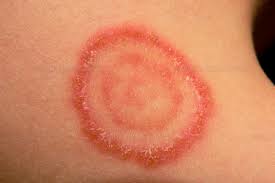Dermatophytosis - Symptoms, Causes, Prevention & Homeopathic treatment

Overview
Dermatophytosis, commonly known as ringworm, is a fungal infection affecting the skin, hair, and nails. It is caused by dermatophytes, a group of fungi that thrive in warm, moist environments. Despite its name, ringworm has nothing to do with worms. The condition is characterized by circular, itchy rashes and is highly contagious. Dermatophytosis can affect individuals of all ages and is commonly seen in areas with high humidity or in individuals who have frequent skin-to-skin contact.
Symptoms
The symptoms of dermatophytosis can vary based on the affected area:
Skin
- Rashes: Circular, red, and scaly patches with a raised border and clear center.
- Itching: Persistent itching or irritation in the affected area.
- Scaling: Dry, flaky skin on the surface of the rash.
- Blisters: In some cases, small fluid-filled blisters may appear.
Hair
- Hair Loss: Patches of hair loss on the scalp or body where the fungi have infected hair follicles.
- Itching: Itching or tenderness on the scalp.
Nails
- Discoloration: Thickened, discolored, or brittle nails.
- Deformation: Changes in the shape and texture of the nails.
When to See a Doctor
Seek medical attention if:
- Persistent Symptoms: Symptoms do not improve with over-the-counter antifungal treatments.
- Severe Infection: The infection spreads rapidly or causes significant pain or discomfort.
- Complications: Symptoms worsen or lead to secondary infections.
- Systemic Symptoms: If you experience fever or other systemic symptoms along with the rash.
Causes
Dermatophytosis is caused by dermatophytes, which are fungi that require keratin to grow. The main types of dermatophytes responsible for the infection include:
- Trichophyton: A common cause of ringworm affecting skin, hair, and nails.
- Microsporum: Often responsible for ringworm of the scalp.
- Epidermophyton: Primarily affects the skin and nails.
The fungi thrive in warm, moist environments and spread through:
- Direct Contact: Skin-to-skin contact with an infected person or animal.
- Indirect Contact: Contact with contaminated surfaces, such as gym equipment, towels, or clothing.
- Infected Animals: Contact with pets or animals carrying the fungus.
Risk Factors
Several factors can increase the risk of developing dermatophytosis:
- Warm, Humid Environments: Fungi thrive in moist and warm conditions.
- Close Contact: Living in crowded conditions or having close contact with infected individuals.
- Weakened Immune System: Individuals with compromised immune systems are more susceptible.
- Sweating: Excessive sweating or wearing tight, non-breathable clothing can increase risk.
- Pre-existing Skin Conditions: Conditions like eczema or psoriasis can make the skin more vulnerable to fungal infections.
Complications
If left untreated or if treatment is delayed, dermatophytosis can lead to:
- Secondary Bacterial Infections: The affected skin can become infected with bacteria.
- Chronic Infection: The infection may become chronic and difficult to treat.
- Scarring: Persistent or severe infections may result in scarring or permanent changes in skin appearance.
- Dissemination: In rare cases, the infection may spread to other parts of the body or to deeper tissues.
Preventions
To prevent dermatophytosis:
- Maintain Good Hygiene: Regularly wash and thoroughly dry the skin, especially in areas prone to sweating.
- Avoid Sharing Personal Items: Do not share towels, clothing, or personal items with others.
- Wear Breathable Clothing: Choose loose-fitting, breathable clothing to reduce moisture buildup.
- Protective Measures: Use protective footwear in communal areas such as swimming pools or gym showers.
- Prompt Treatment: Treat any signs of infection early to prevent spreading.
Can Homeopathy Help?
Homeopathy provides a personalized approach to treating dermatophytosis by focusing on the individual’s overall health and specific symptoms. Homeopathic remedies are selected based on the characteristics of the infection and the patient’s overall condition. A qualified homeopathic practitioner will conduct a detailed assessment to determine the most appropriate remedy based on the individual’s specific symptoms and overall health.
Diagnosis
Diagnosing dermatophytosis typically involves:
- Clinical Examination: A visual inspection of the skin, hair, or nails to assess the characteristic appearance of the infection.
- Microscopic Examination: A sample of skin, hair, or nail may be examined under a microscope after being treated with potassium hydroxide (KOH) to identify fungal elements.
- Culture: A fungal culture may be performed to identify the specific type of dermatophyte causing the infection.
- Wood’s Lamp Examination: A special light may be used to detect fluorescence produced by some types of dermatophytes, particularly Microsporum species.
Treatments
Treatment options for dermatophytosis include:
- Topical Antifungals: Creams, ointments, or powders containing antifungal agents such as clotrimazole, miconazole, or terbinafine.
- Oral Antifungals: Oral medications such as terbinafine, itraconazole, or fluconazole for more extensive or resistant infections.
- Proper Hygiene: Maintaining good hygiene and keeping the affected area clean and dry.
- Avoiding Irritants: Avoiding harsh soaps or lotions that can further irritate the skin.
Lifestyle and Home Remedies
Supporting conventional treatments with lifestyle and home remedies can help manage and prevent dermatophytosis:
- Tea Tree Oil: Known for its antifungal properties, diluted tea tree oil can be applied to the affected area.
- Apple Cider Vinegar: Applying diluted apple cider vinegar may help reduce fungal growth and relieve itching.
- Coconut Oil: Coconut oil has antifungal properties and can soothe irritated skin.
- Aloe Vera: Aloe vera gel can help calm inflammation and promote healing.
Preparing for Your Appointment
To make the most of your appointment with a healthcare provider or homeopathic practitioner:
- Document Symptoms: Keep a record of symptoms, including their onset, location, and any changes over time.
- Medical History: Provide information about any previous treatments or infections, and any relevant medical history.
- Lifestyle Factors: Share details about your daily activities, hygiene practices, and any recent changes in environment or habits.
- Questions: Prepare a list of questions regarding treatment options, potential side effects, and preventive measures.

